What is Light?
Jack Kramer
Astronomers are very much involved with this thing called light. We talk about the "light gathering" power of our telescopes and try to see as much as possible of the light that's transmitted by objects millions of light years away. But what exactly is it? Many textbooks and encyclopedias refer to light as "waves", pointing out that such things as diffraction and polarization could not be explained unless light were a form of wave. However, there are many characteristics that cannot be explained unless light is considered as a particle. The true nature of light is still uncertain. There have been various theories about the nature of light, and to this day, there is no universal agreement as to which theory correctly explains this phenomenon. But if there were clear answers to all problems, then there would be no point to scientific inquiry. For now, let's just describe it.
Today, an increasing number of physicists regard light as particles - photons - as explained in the science of Quantum Electrodynamics. Stephen Hawking commented on this in his book Black Holes and Baby Universes:
"In 1905...Einstein wrote about a phenomenon called the photoelectric effect. It had been observed that when light fell on certain metals, charged particles were given off. The puzzling thing was that if the intensity of the light was reduced, the number of particles emitted diminished, but the speed with which each particle was emitted remained the same. Einstein showed this could be explained if light came not in continuously variable amounts, as everyone had assumed, but rather in packets of a certain size. The idea of light coming only in packets, called quanta, had been introduced a few years earlier by the German physicist, Max Planck...but he regarded quanta simply as a theoretical trick, one that didn't correspond to anything in physical reality. Einstein's paper showed that you could directly observe individual quanta. Each particle emitted corresponded to one quantum of light hitting the metal."
As you can see, the widely-used term "quantum leap" is a misnomer. What you are really saying is that the leap is rather tiny, since "quantum" refers to a very minute particle. A more correct word to signify a very large increase would be an "exponential leap".
Richard P. Feynman in his book QED also explains effects that argue in favor of considering light as a particle:
"We know that light is made of particles because we can take a very sensitive instrument that makes clicks when light shines on it, and if the light gets dimmer, the clicks remain just as loud -- there are just fewer of them. Thus light is something like raindrops -- each little lump of light is called a photon -- and if the light is all one color, all the 'raindrops' are the same size."
The instrument about which he's speaking is known as a photomultiplier. The charged particles are electrons, which are attracted to a positively-charged plate. When they strike this plate, they give off more electrons, which strike other plates. Eventually, there are enough electrons to produce a measurable electric current, which can be amplified so that the sound is heard through a speaker. The following diagram shows how this works.
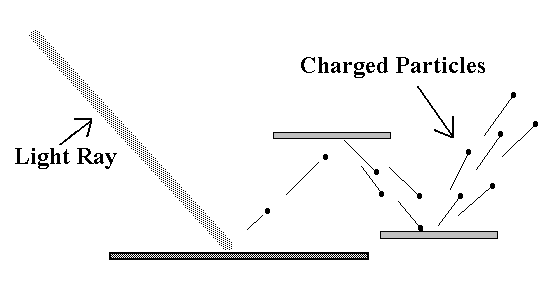
Considering the different arguments for light as a wave or as a particle, perhaps the most informative thing we can do is to simply describe light in terms of what it does.
Reflection of light in a sheet of glass varies continuously between 0% and 16%, depending on the thickness of the glass. Part is reflected from the front surface and part from the rear. Why this happens is unknown.
Light is affected by the medium through which it travels; it moves
- faster in air than in water or glass
- faster in hot air than in cold air
Obviously, when we say that light travels at 186,000 miles per second, that's sort of an average. But in the vacuum of space, there's nothing to impede the movement of light, and we're able to accurately measure distances by how far light travels in one year -- the good old light year. (So when someone asks you "What's a light year?", don't reply "One third less filling than a regular year"!) The movement of light is time-dependent -- it always takes the quickest route (the path of least time). The following shows how light moves in water.
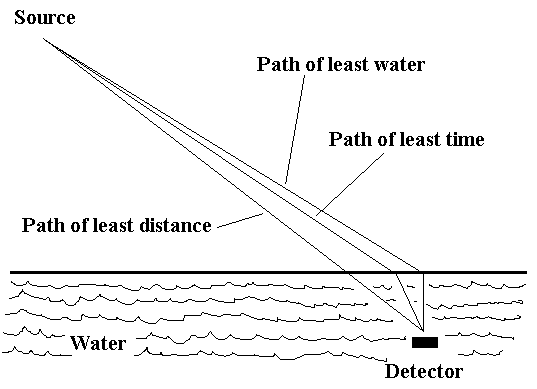
These properties of light explain why we see certain phenomena. An oil slick is like an uneven sheet of glass. Colors are seen because red light is slower than blue light. The human eye sees light as white unless something alters how the light arrives at our eyes. The cycle of 0% to 16% repeats more quickly for blue light than for red. So, in effect, the different colors reach our eyes at different times, depending on where we are looking. We see a mirage such as "water" on the surface of a hot roadway because the reflection of the sky moves faster in the hot air near the road than does the image of the road surface itself.
Now let's look at another property of light. Light is reflected from all points on a mirror, as shown in the diagram that follows. (We are assuming this is a front-surface mirror.)
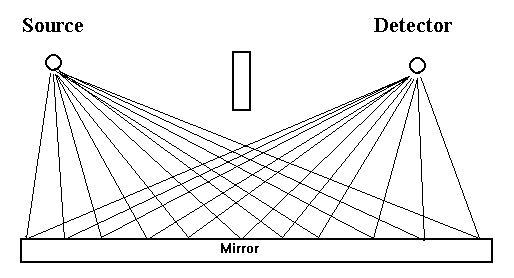
If it were possible to use a stopwatch to time the movement of photons from the source to the detector, the times near the center would be the shortest, and they would be nearly equal. (The stopwatch dial would have to spin at 36,000 revolutions per inch for red light, and even faster for blue light.) Because the light from the center strikes our eyes first, that is the reflection that we see. The variations in speed at the ends is greater, so the hand on the stopwatch would show a greater variation. We don't see this light, because the photons tend to cancel each other out. The hand of our imaginary stopwatch would look something like the following for various spots on the mirror.

A diffraction grating cuts out certain parts of the mirror, generally using grooves, so that the arrows (the hand of our stopwatch) assume a predominant direction depending on the colors.

It is the speed of different colored light that is most important, and as a result, we're able to see the rainbow effect when we look at a diffraction grating.
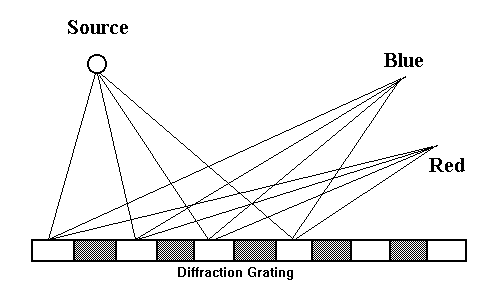
Light passing through a lens takes advantage of the varying speed through the medium. A lens is able to focus light because the varying thickness of the glass causes light to be slowed more at the center than at the edges.. As a result, light passing through at the edge of the lens reaches your eye at the same time as the light that passes through the center.
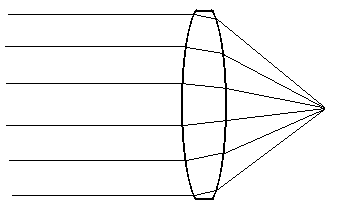
It is the study of quantum electrodynamics that addresses the questions about light. This is pretty deep science. I've tried here to describe some of the things that have been said about light, with the help of admittedly over-simplified illustrations. So whether it's a wave, a particle, or some of both, here's what we know about the properties of light:
- moves faster in air than in other media
- moves faster in warm air than cold
- is time-dependent -- takes the quickest route
- is reflected by all parts of a mirror
For more details, I recommend the Richard Feynman book QED, which stands for Quantum ElectroDynamics. The beauty of this work is that not only did he use very few formulas, but he presented the material in a conversational style. The book requires careful reading, but the material becomes understandable as you follow his line of thought and perhaps review certain passages.
Published in the June 1997 issue of the NightTimes




